Purchasing a PC was a significant investment, and you don’t know what to do without your machine. That is why you want to do everything you can to ensure it works optimally. Finding the best software to monitor CPU and GPU Temp for Windows is essential to taking care of your computer.
We gathered the most reliable utilities for Windows 7, 8, 10 and 11 and listed them in our reviews below. Check out our guide to learn how to pick a CPU temperature monitoring tool that fits your preferences!
Quick Summary
- Our top pick for the best software to monitor CPU temp is Speccy. Piriform, the creators of CCleaner, designed this small but powerful utility app. It weighs less than 10MB, but it can provide real-time and accurate info about the temperature of your processor and GPU. The data you receive with this program can be printed, saved, and published online in a couple of clicks.
- Core Temp is another excellent suggestion for monitoring CPU temp. The software utilizes digital thermal sensors (DTS) that deliver reliable information about the heat level in your processor.
- HWMonitor is the third top pick that deserves a recommendation. The simple installation and beginner-friendly interface ensure you receive all-around information about your computer. You can choose to get temperature information for each core and save data by using .txt files.
Part 1. What Is a CPU Temperature Monitor?
A CPU temperature monitor is a specialized software that measures heat levels in your processor. Keeping the temperature adequate at all times is essential for both CPU and GPU. Monitoring software allows you to discover a potential heat change as soon as the temperature increases.
Part 2. Who Should Get A PC Temperature Monitoring Software?
It is not an exaggeration to say that everyone who owns a PC can benefit from a CPU temperature monitor.
Here are some situations when you could benefit from these apps:
- You want to stay informed about your system data – monitoring tools are a great way to confirm that things are going smoothly inside your machine and there are no potential problems.
- Your computer had problems before – did you have overheating issues before? If the answer is yes, installing a monitoring utility can be crucial.
- You have an old computer – older machines are more prone to overheating problems, so staying on top of the potential issues is critical.
Part 3. How We Tested and Picked the Best Software to Monitor CPU and GPU Temp in 2024
Here is the list of main factors to consider when selecting a suitable CPU and GPU monitoring tool.
Does It Measure Both CPU and GPU?
The basic monitors focus on tracking only CPU temperature. However, GPU also plays an advanced role nowadays, especially for gamers. That is why you can benefit from software monitoring temps in both areas.
Can It Measure the Temperatures of All Cores?
Modern PCs use processors with multiple cores. That is why the best software to monitor CPU temp for Windows 10 should provide heat information about every core. Depending on the tool, you might get statistics on average temperature, too.
Can You Set Alerts If the Heat Level Increases?
While heat monitoring is great, what if the temperature increases and you don’t notice it? That is where these alerts come into play. As soon as the tool notices something weird, it sends you a notification to act to prevent overheating problems. Most programs allow you to pick the upper-temperature limit and will send a notification when that restriction is crossed.
Is It Possible to Save and Share Reports?
Saving and sharing reports, including system information, is an option in most CPU temp monitoring solutions. Some apps will offer you to save files in multiple formats, such as TXT and XML. You might be able to print reports or publish them online and even load snapshots to compare statistics.
Does It Offer Advanced Features and Adjustments?
We’ve come to an important item of discussion – advanced features of temperature monitoring tools. Some apps will allow you to adjust fan speed and other factors affecting system performance.
Does It Suit Your Budget?
Considering the price is normal when you are getting any product. The good news is that CPU and GPU monitoring tools can be free and premium. That means you can get these apps for free and get information about CPU heat without paying a single cent. Premium versions, however, include additional features that can make the tool even more useful.
Part 4. Our Picks: Best CPU Temperature Monitor in 2024
1. Speccy
Speccy is a handy tool developed by Piriform Ltd. It is the same company behind CCleaner, which is among the leading apps for maintaining PCs and keeping them in optimal condition.
As for Speccy, it is a lightweight tool with an installer that weighs less than 10MB. Besides that, the software is also fast and capable of providing accurate and real-time info.
This is far more than the best PC temperature monitoring software. The tool will provide detailed information on what’s going on inside your computer.
Here are the main features of the program:
- Monitor CPU temperature by cores and receive information on average temperature
- See GPU temperature and other information about graphics
- Receive data about other components that are a part of your system
- Save, load, print, and publish snapshots with your system information
Does Speccy Work? Hands-On Testing
This is the screen you will see once you open the software.
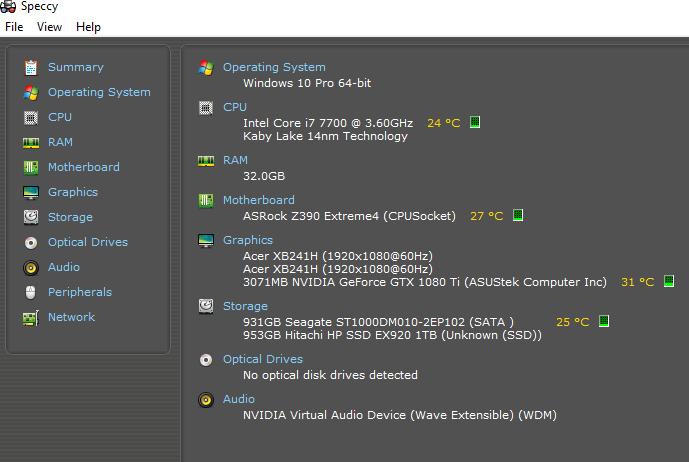
It immediately gives you a summary of the most important data about your system. The home screen indicates temperatures of the CPU, motherboard, graphics, and storage, as well as other useful information.
A green light indicates the temperature is optimal, while red means you should do something to lower the heat.
Now, take a look at the tabs available in the upper section.
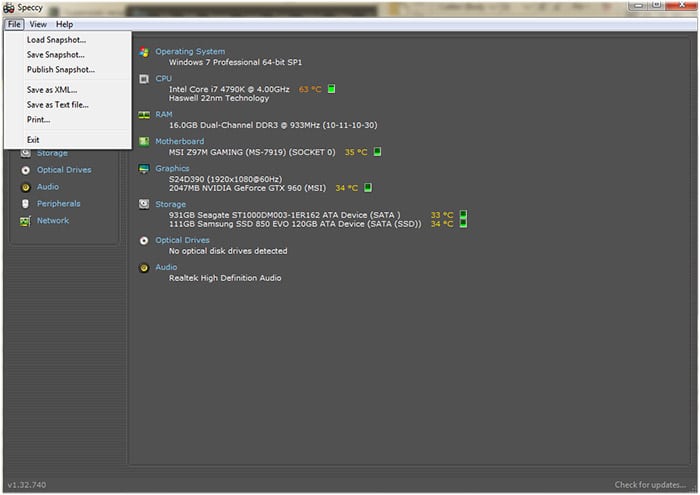
These options serve to save and share your current system specifications. You can save snapshots on your computer in the default “speccy” format and as a text or XML file. It is also possible to save an image, print the information, or share it with the “Publish” function.
The next tab is “View,” which allows you to adjust whether you want the navigation menu visible or not. If not, you need to use this section to find your way between the subcategories. Users can also click on “Refresh” or use the CTRL+R shortcut to reload system information at any point. Reloading is fast, which is why this is the best software to monitor CPU and GPU temperature on the market.
If you choose “Options” from the “View” menu, you will get the following pop-up:
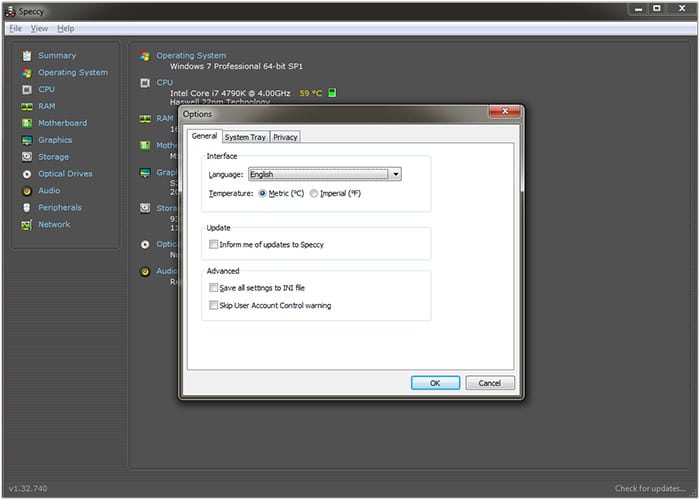
The software supports more than 30 languages. You can also change between imperial and metric units (Fahrenheit and Celsius) to display temperatures.
If you return to the main screen, you notice five subsections on the left. You can get useful information on the operating system, RAM, storage, audio, and peripherals. However, we will focus on the CPU and graphics.
Here is how the CPU tab looks.
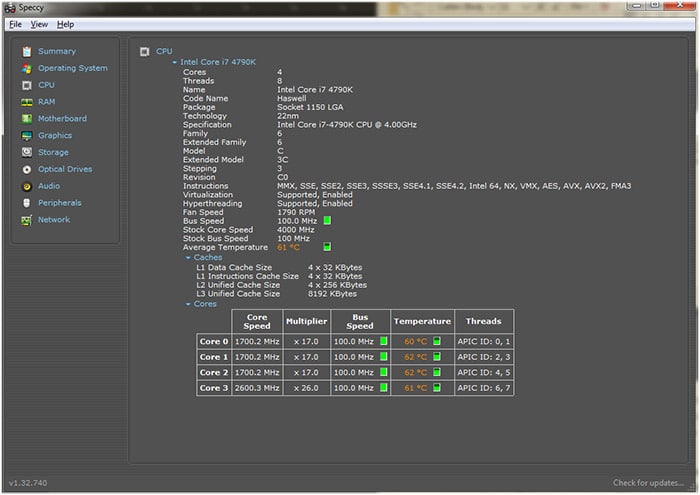
Speccy will show the basic information about your CPU, such as its name, cores, and threads. As for the temperature, there is the average temp level and the specific heat level for every core. The light indicators also help you discover if anything is outside the recommended levels.
It is similar to the Graphics tab.
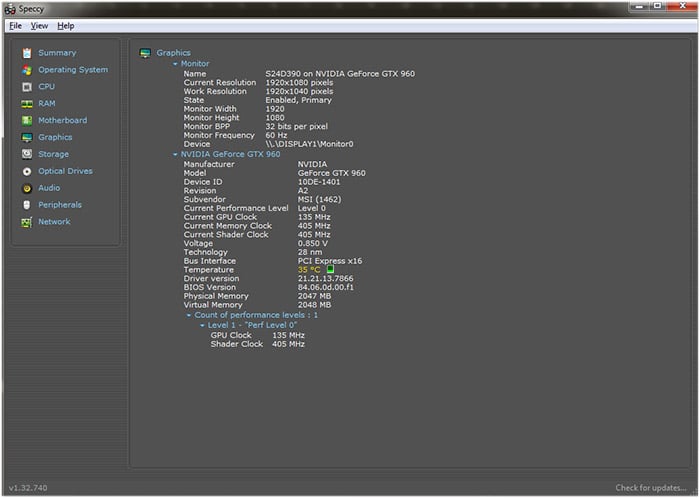
The temperature is the crucial point here, but you can also benefit from learning more about the graphic card used on your PC.
Speccy is a useful tool, and even the free version provides all the necessary information you need. If you purchase the premium edition, you will receive premium support and automatic updates. Acquiring the CCleaner bundle can be an excellent way to detect and eliminate any issues on your machine. But as far as temperature monitoring goes, Speccy is more than enough to provide accurate and real-time information about CPU and GPU heat levels.
2. Core Temp
Core Temp is our next candidate for the best program to monitor CPU temp. It is free for personal use, although the creators ask business users to contact them to obtain a license.
The software can provide important processor information, including the temperature of the cores and other useful readings. Core Temp utilizes the so-called DTS – digital thermal sensors. These enable real-time and accurate portrayal of the temperature because the sensors are placed close to the hottest part of the core.
The app can read Intel, AMD, and VIA processors. It can work on Windows XP and later, as well as Windows Server from WS 2003. Apart from the Windows utility, you can also install the temp gadget on Windows 7 or download a gadget for Windows Phone and Android.
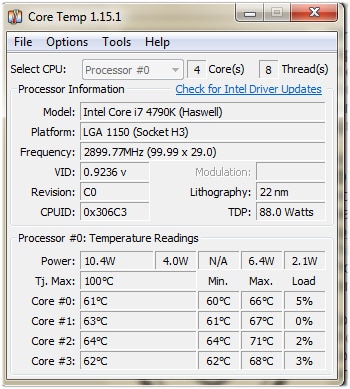
The top menus offer convenient options, such as refreshing (you can also use F5), choosing the temperature scale, and setting temperature protection.
Choose “Options,” click on “Overheat Protection,” and tick the box to activate this feature.
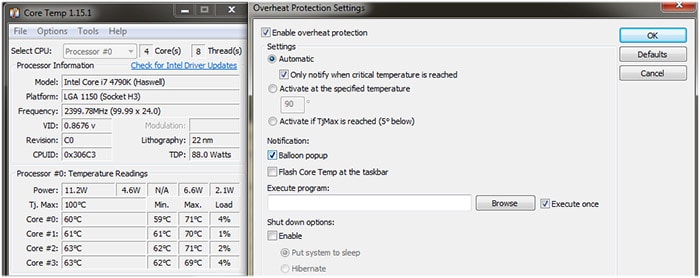
If it reaches a critical level, it informs you right away. That way, you can do something before the high heat can potentially damage your processor.
3. HWMonitor
HWMonitor is a useful tool for delivering relevant information about a PC system. The app supports Windows 32 and 64-bit versions and only takes a tiny portion of hard drive space.
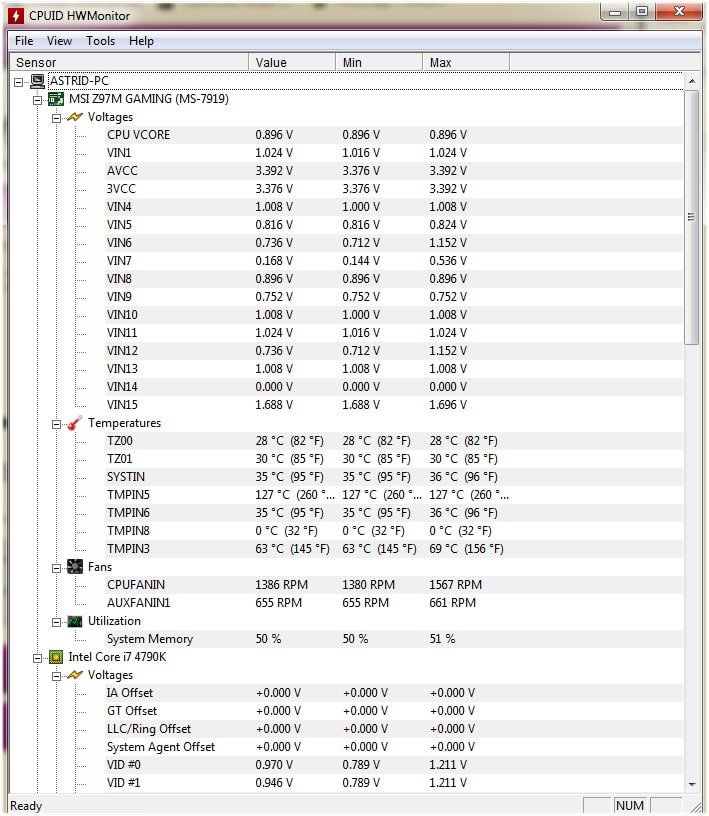
You can see important information about temperatures, voltages, and the fan speed of your machine. The components are divided into sectors. If it is easier, you can close and expand sectors as necessary.
If you optimize everything right, you will see both CPU and GPU without scrolling.
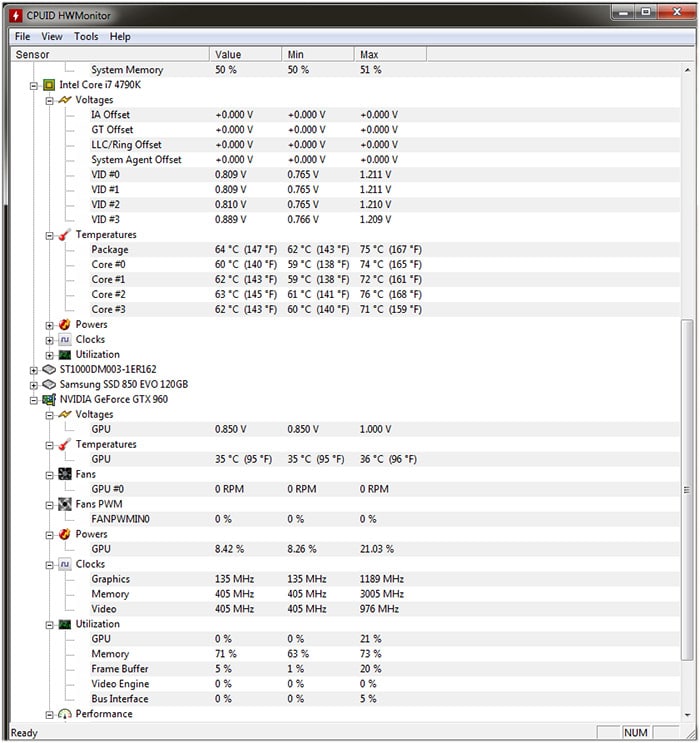
The temperature information about the processor shows the heat level by the core. As for the graphics, you can see all the relevant info about their performance. It is quite basic, but that doesn’t stop HWMonitor from being among the best CPU and GPU temp monitoring software.
The program doesn’t have plenty of additional options for adjusting. You can save monitoring information only as .txt files and check for driver and software updates.
HWMonitor is available in the free and pro version. The premium HWMonitor Pro adds remote monitoring of Android and PC machines through a TCP/IP connection and features an improved interface and graphic statistics of monitoring information.
4. SpeedFan
SpeedFan only takes less than 10MB of space on your hard drive, like other utilities for monitoring temperatures. But it is not the fastest software out there, and it will require a bit of patience to enter the main screen.
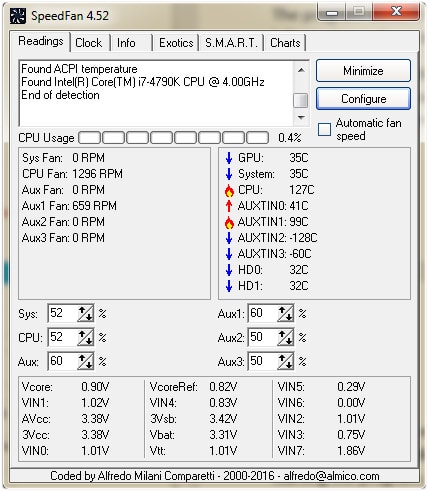
You can’t say that the interface is beginner-friendly. If you have sufficient tech knowledge, you will understand the provided information. That is why SpeedFan is primarily designed for advanced users.
That being said, the utility is fairly powerful. It can read temperatures, fan speeds, voltages, and even S.M.A.R.T. data. You can use the software on Windows 9x and later, which gives the software impressive versatility.
The great thing about SpeedFan is that you can configure it to fit your needs. That means you can adjust fans to work based on the temperature readings. It is not advised to play with the settings unless you know what you are doing. Fortunately, the developer created a useful help guide, and you shouldn’t hesitate to contact him if you have a question.
Overall, SpeedFan is a powerful tool, but it is not the best choice for beginners and those without the required tech knowledge.
5. Open Hardware Monitor
Open Hardware Monitor is an open-source program free for everyone. The software supports Windows and Linux operating systems, and you can use it on the latest Windows 11. The tool reads sensors of AMD and Intel processors, as well as Nvidia and ATI video cards.
But is it the best GPU temp monitoring software? Considering that it is free, Open Hardware Monitor is quite versatile and useful.
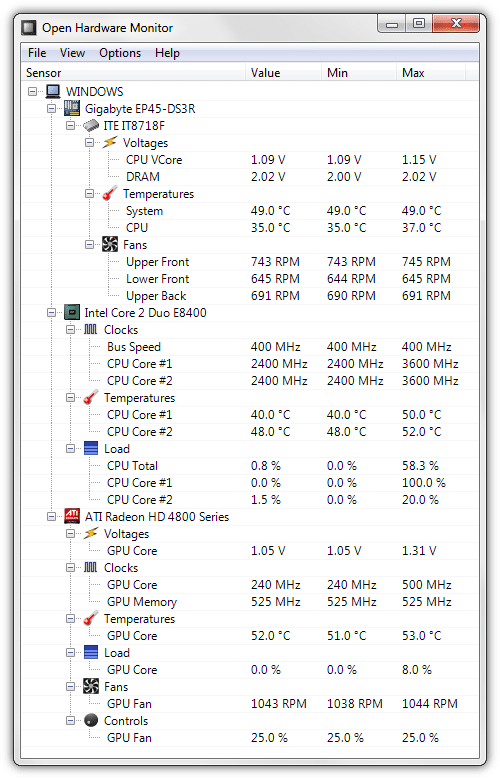
Everything is immediately visible from the main screen. The app will read processor temperatures and list them depending on the core. It will also show GPU heat levels and information about fans, clocks, and voltages.
Since it is an open-source application, you can submit the report via the Open Hardware Monitor app to help the authors improve the tool. It is possible to save reports as text files and pick which sections of system information to view.
You can choose between standard temperature units (the default is Celsius, but you can change it to Fahrenheit). Adjusting the logging intervals from a single second to six hours ensures you get updated information at the desired frequency.
It is important to note that the Open Hardware Monitor uses the Microsoft .NET framework.
6. Real Temp
Real Temp is another interesting free utility that can read CPU temperature. But the software only worked on Intel processors, which means AMD users cannot use it.
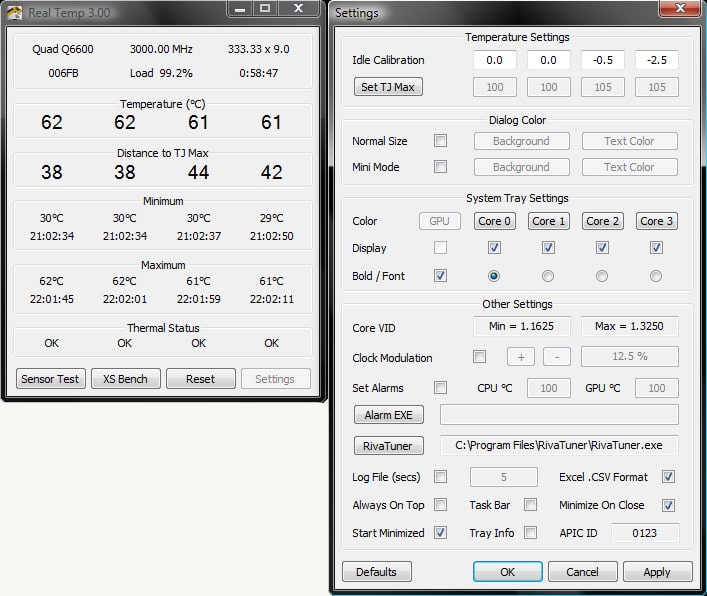
The numbers might seem confusing initially, but everything is grouped well. The central section offers current temperatures and the distance to TjMax. That is the distance to the maximum temp level recommended for safe core operation. Additionally, the system will offer minimum and maximum temperatures recorded since the program was installed. Finally, the Thermal Status at the bottom will show you if there is any reason to worry about CPU heat.
Conclusion
It is critical to understand that you need to take care of your PC to prolong its lifespan and ensure it works optimally. Installing the best software to monitor CPU and GPU temperature is an excellent way to discover overheating before it becomes a major issue.
Pick one of the tools listed in this article, and you can’t go wrong because they will always provide accurate temperature data and system information!



